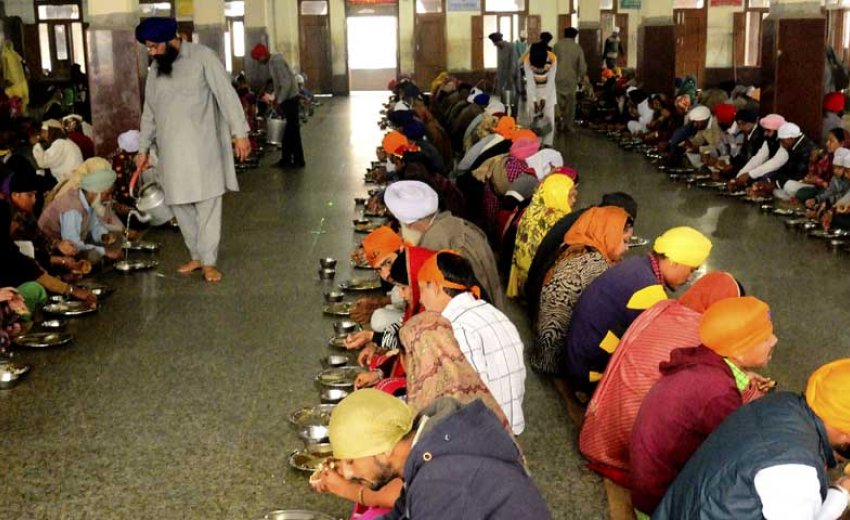Three noisy machines tirelessly work, converting 12 tons of whole wheat flour daily into nearly a quarter-million flatbread discs known as roti. These purpose-built contraptions, each stretching 20 feet long, perform a series of actions—extruding the dough, flattening it, and finally, sending it along a gas-fired conveyor belt. The result? A continuous flow of hot, perfectly round rotis that never seems to cease.
Aromatic piping hot langar
Huge pots of flavorful lentil soup, enough to fill three and a third tons, simmer over fires tended by bearded, shoeless men using giant wooden spoons. The delicious scent in the air comes from a mix of 1,700 pounds of onions, 132 pounds of garlic, and 330 pounds of spicy red chilies.
This incredible scene takes place at the Golden Temple in this city, home to the Sikh religion's most sacred site. Here, the langar, a massive community kitchen, serves as perhaps the world's largest free eatery. As lunchtime approaches, the kitchen is bustling with activity. Thousands of volunteers have cleaned, chopped, and prepared ingredients. They've readied over 40,000 metal plates, bowls, and spoons for the upcoming rush of visitors.
Serving nutritious meals
Everyone is welcome to enjoy free meals here, and a lot of people do just that. On weekdays, around 80,000 visitors show up, but on weekends, nearly double that number come by. Each person receives a nutritious vegetarian meal, served by volunteers representing India's diverse religious and ethnic backgrounds.
Harpinder Singh, the 45-year-old manager of this huge operation. “This is our tradition,Anyone who wants can come and eat.”
Men without shoes use wooden spoons to stir big pots at the Golden Temple's kitchen, where around 80,000 people eat on weekdays and nearly double that on weekends. The Golden Temple, rooted in Sikhism from 15th-century Punjab, rejects the caste system central to Hinduism. This idea is alive in their community kitchen, where everyone—regardless of faith, wealth, or status—is seen as equals.
The brewing of ‘langar’ culture in India
India, known as the world's largest democracy, is also incredibly diverse spiritually. Its birth was marked by religious conflict as British India was divided to form Pakistan, but since independence, India has stood as a secular nation. It has embraced a wide spectrum of beliefs about humanity, God, and the soul.
Few places in India showcase its diversity and tolerance quite like this one. India has managed to stay united despite its divisions, largely due to its celebration of differences and acceptance.
Sikhism, originating in the Punjab region during the 15th century, strongly opposes the caste system inherent in Hinduism.The Golden Temple, a massive complex made of marble and shimmering gold, sits in the heart of the bustling city, Amritsar near the Pakistan border. It aims to represent this principle of equality. This is most evident in its community kitchen, where each one, regardless of religion, wealth, or social standing, is treated as equal.
Sprouting concept of ‘community kitchen’ in Sikhism
Guru Amar Das, the third Sikh guru in the 16th century, established a community kitchen aimed at bringing people together. He believed in the equality of all humanity. One painting at the temple’s museum depicts the guru’s wife serving common folks tirelessly in the kitchen, emphasizing the spirit of humble service.
For five years now, Ashok Kumar, a Hindu man with a scruffy beard, has dedicated most of his days to the kitchen, volunteering tirelessly. He sees it as his way of serving others. Covered with a white rag and hands wrapped like a boxer's, his main task is handling a heavy bucket for collecting dirty plates and bowls.
Positioned at the end of an organized assembly line, his role begins with gathering spoons, clearing leftover food, and then receiving stacks of dirty dishes for washing. Despite the flurry of plates and bowls aimed his way, he skillfully redirects them into the washing tubs using metal plates as shields, arranging plates around the rim and stacking bowls in the center.
Mr. Kumar used to be a bookbinder.
“I feel happy here,” he says when asked why he had given up his old life.
A Sikh Temple Where All May Eat, and Pitch In
Volunteers from different backgrounds, beliefs, and social standings gather at the Golden Temple in India. They wash dishes and serve nourishing vegetarian meals to all visitors. This act embodies India's diverse religious and cultural mix. People of various faiths seek solace here, away from the noisy hustle of India's massive population. Just as shoes are left at the temple gates, the chaos of city life stays outside.
The temple stands out for its pristine environment and organization. The only sounds are the harmonium's melody and the gentle steps of visitors. The place is meticulously cleaned multiple times a day.
However, it wasn’t always peaceful. In the past, a Sikh insurgency aiming for a separate Sikh homeland in Punjab caused great turmoil. In 1984, then-Prime Minister Indira Gandhi ordered a violent operation at the temple, resulting in casualties among militants and damage to the temple. Tragically, Mrs. Gandhi was later assassinated by Sikh bodyguards in retaliation for the temple attack.
Despite the past, Sikhs are firmly integrated into India's core, holding key roles in arts, government, and business. Manmohan Singh, India's former prime minister, is a prominent Sikh.
Pankaj Ahuja, a Rajasthan-based owner of a medical supply shop, recently visited the temple with his wife and son for their first time. They traveled aboard the Golden Temple Express and stayed in the free pilgrims' dormitories. Although they are Hindus, the temple holds a unique importance for his family.
“You have lots of religious places in this country,” said Mr. Ahuja’s wife, Nikita. “But the kind of peace and cleanliness you find here you won’t find anywhere else.”
In her hometown, Mrs. Ahuja's status would make cleaning floors seem beneath her; typically, people from lower castes perform these tasks. However she joyfully takes on the task of scrubbing floors at the temple.
“In normal life, I would ask, ‘Why should I do this?’ It is shameful to clean floors,” she says. “But here, it is different.”
She doesn't think about who cooked the food, even though in India's caste traditions, it's really important to know. The caste system in India makes it significant to consider who handles food preparation.
“It is more than food,” she said of the meals that she had eaten at the community kitchen. “Once you eat it, you forget who is cooking, who is serving it, who is sitting next to you.”
Anil Kumar, a 32-year-old Hindu, was up to his elbows in soapy water at one of the washing troughs.
“At home, I would never do this,” he said with a laugh. “It is my wife’s work.”
But he says that he tries to come for at least an hour every day to wash dishes. “It is not a question of religion,” he added. “It is a question of faith. Here I feel a feeling of peace.”
The kitchen at the Golden Temple whispers a powerful message that faith and humanity find their purest expression not in division, but in a shared meal and a quiet prayer.Here, differences dissolve, leaving only the grace of a common humanity, nourished by food and fellowship.
*Based on an article by Lydia Polgreen published in NY Times on 31st August 2010

